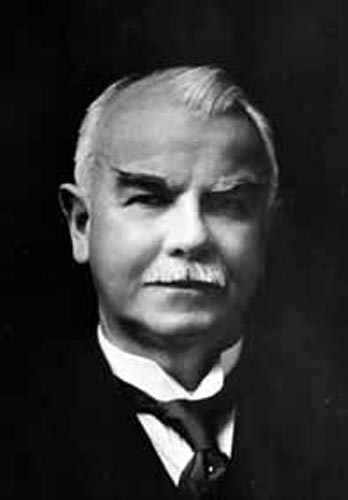- James Alfred Ewing
Infobox Scientist
name = James Alfred Ewing
box_width =
image_width =200px
caption = James Alfred Ewing
birth_date =27 March 1855
birth_place =
death_date =7 January 1935
death_place =
residence =
citizenship =
nationality = Scottish
ethnicity =
field =physicist andengineer
work_institutions =
alma_mater =
doctoral_advisor =
doctoral_students =
known_for =hysteresis
author_abbrev_bot =
author_abbrev_zoo =
influences =
influenced =
prizes =
religion =
footnotes =
Sir James Alfred Ewing KCB (27 March 1855 -7 January 1935 ) was a Scottishphysicist andengineer , best known for his work on the magnetic properties ofmetal s and, in particular, for his discovery of, and coinage of the word, "hysteresis ".(Note: According to the book "Sir Alfred Ewing: A Pioneer in Physics and Engineering" (1946) by Professor Bates, the discovery of magnetic hysteresis probably occurred before Ewing. However, Ewing re-discovered it, studied it in detail and coined the word "
hysteresis ". Please see reference below.)Life
Early life
Born in
Dundee ,Scotland , the third son of a minister of the Free Church of Scotland and educated at West End Academy and theHigh School of Dundee , Ewing showed an early interest inscience andtechnology .Ewing graduated in
engineering from theUniversity of Edinburgh where he studied underWilliam Thomson, 1st Baron Kelvin andPeter Guthrie Tait . During his summer vacations, he worked ontelegraph cable laying expeditions, including one toBrazil , under Thomson andFleeming Jenkin .Japan
In 1878, on Fleeming Jenkin's recommendation, Ewing was recruited to help the modernisation of
Meiji Era Japan as one of the "o-yatoi gaikokujin " (hired foreigners). Serving as professor ofmechanical engineering at theUniversity of Tokyo , he was instrumental in founding Japaneseseismology .Ewing made two special friends at Tokyo University soon after arriving:
Basil Hall Chamberlain and LieutenantThomas Henry James R.N. who taught navigation. He was also in close contact withHenry Dyer andWilliam Edward Ayrton at theImperial College of Engineering (Kobu Dai Gakko).In Tokyo, Ewing taught courses in mechanics and on heat engines to engineering students, and electricity and magnetism to students of physics. He carried out many research projects on magnetism and coined the word 'hysteresis'. His investigations into earthquakes led him to help T. Lomar Gray and
John Milne of the Imperial College of Engineering to develop aseismometer . All three men worked as a team on the invention and use of seismographs, though Milne is generally credited with the invention of the first modern horizontal-pendulum seismograph.cotland
In 1883, Ewing returned to Scotland to work at the University College Dundee where he was appalled by the living conditions of many of the poorer areas of the town which he felt compared unfavourably with those in Japan. He worked fervently with local government and industry to improve amenities, in particular
sewer systems, and to lower theinfant mortality rate .University of Cambridge
In 1890, he took up the post of professor of mechanism and applied mechanics at
King's College, Cambridge . At Cambridge, Ewing's research into the magnetisation of metals led him to criticise the conventional account ofWilhelm Weber . In 1890, he observed that magnetisation lagged behind an appliedalternating current . He described the characteristic hysteresis curve and speculated that individual molecules act as magnets, resisting changes in magnetising potential. Ewing was a close friend of SirCharles Algernon Parsons and collaborated with him on the development of thesteam turbine , participating in the sea-trials of the "Turbinia ". He also researched into thecrystal line structure of metals and, in 1903, was the first to propose that fatigue failures originated in microscopic defects or "slip bands" in materials.University of Edinburgh
In 1903, he became director of naval education at the
Admiralty before becoming principal and vice-chancellor of theUniversity of Edinburgh in 1916, a post he held until his retirement in 1929. From 1914 to May 1917, he managed "Room 40 ", the admiralty intelligence department ofcryptanalysis , responsible predominantly for the decryption of intercepted German naval messages. In this capacity, he achieved some notoriety in the popular press when Room 40 deciphered theZimmermann Telegram in 1917 (which suggested a German plot to assistMexico in annexing the southwesternUnited States ).In May 1916 Ewing accepted an invitation to become Vice-Chancellor of Edinburgh University, in the course of which he instituted an extensive series of effective reforms.
Knighted in 1911, Sir James Alfred Ewing retired from Edinburgh University in 1929 and died in 1935.
Honours
*Fellow of the
Royal Society of Edinburgh (1878);
*Fellow of theRoyal Society (1887);
*CB (1907);
*KCB (1911);
*President of the Royal Society of Edinburgh (1924 - 1929);
*Albert Medal of theRoyal Society of Arts (1929);
*President of theBritish Association for the Advancement of Science (1932);
*TheJames Alfred Ewing Medal of theInstitution of Civil Engineers has been awarded for "specially meritorious contributions to the science of engineering in the field of research" since 1938.Works
*cite book | author=Ewing, J.A. | title=Treatise on Earthquake Measurement | year=1883
*cite book | author=- | title=Magnetic Induction in Iron and Other Metals | year=1891 | location=London | publisher=Van Nostrand
*cite book | author=- | title=The Steam Engine and other Heat Engines | year=1894
*cite book | author=- | title=The Strength of Materials | year=1899
*cite book | author=- | title=The Mechanical Production of Gold | year=1908
*cite book | author=- | title=Thermodynamics for Engineers | year=1920
*cite book | author=- | title=The Mechanical Production of Cold | year=1921 | location=Cambridge | publisher=Cambridge University Press
*cite book | author=- | title=An Engineer's Outlook | year=1933 | publisher=Methuen | location=Londonee also
*
Anglo-Japanese relations
*Room 40 Bibliography
*Bates, L. F. (1946) "Sir Alfred Ewing: A Pioneer in Physics and Engineering" ISBN 1-114-51704-6
*Pedlar, Neil, 'James Alfred Ewing and his circle of pioneering physicists in Meiji Japan', Hoare, J.E. ed., "Britain & Japan: Biographical Portraits" Volume III Chapter 8. Japan Library (1999). ISBN 1-873410-89-1
Wikimedia Foundation. 2010.
